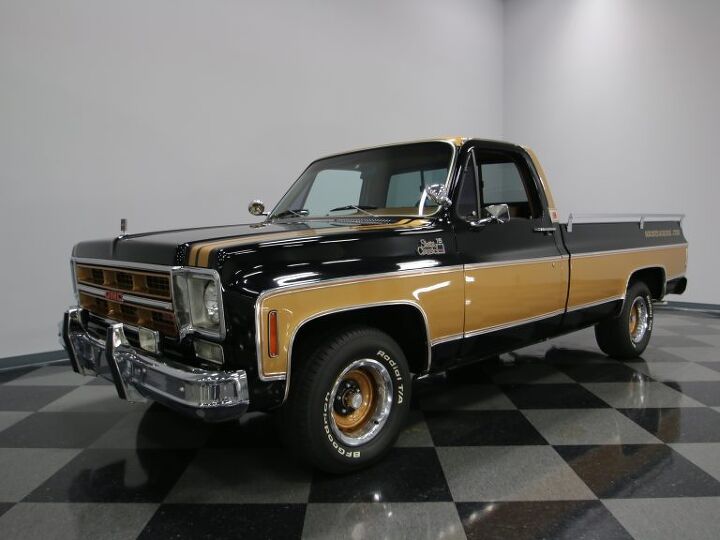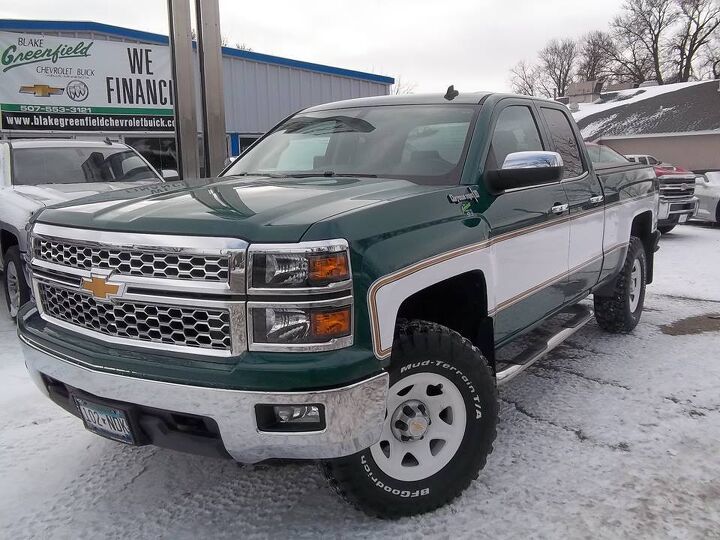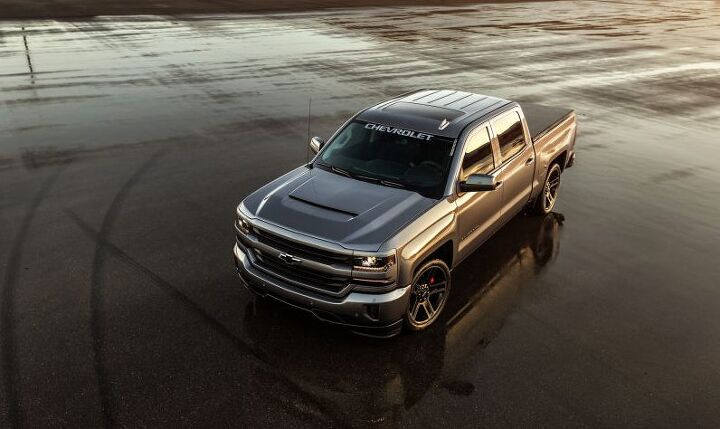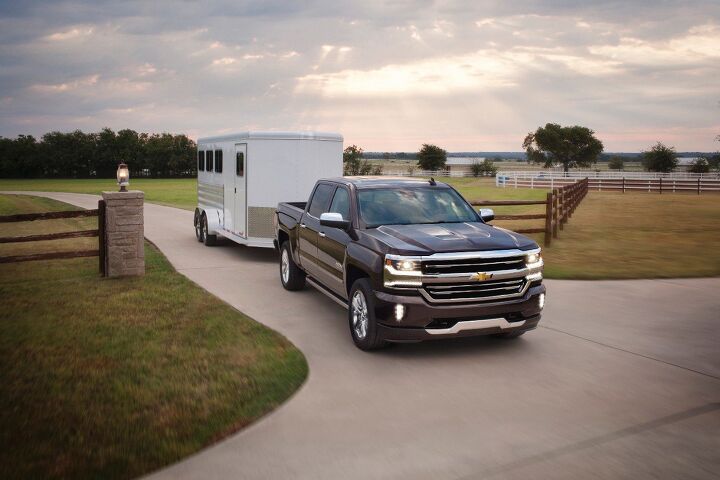#ChevroletSilverado
After a Decade's Absence, the Silverado's Going Big Again
An ill wind blew through Detroit late last decade, prompting all domestic automakers to shed excess weight in order to keep their heads above water. In some cases, automakers shaved off long-running brands like an unwanted hair. Models disappeared, while some prestige nameplates snapped up years earlier went out to the yard sale plastered in discount stickers.
A less flashy side of the recession-era cost-cutting involved the elimination of certain automotive niches. One, General Motors’ medium-duty truck line, failed to find a buyer before bankruptcy tipped GM’s hand. The unit didn’t make it out of the recession alive.
Well, now it’s back. GM has announced the Chevrolet Silverado line will no longer stop at the 3500HD model, and that our first full glimpse of the new medium-duty truck line will come in just two months.
Will They or Won't They? Questions Remain About Silverado/Sierra Production in Oshawa
General Motors is spending billions to upgrade certain factories, prepping them to build the next-generation Silverado and Sierra. As part of a four-year contract agreed to in September 2016, $310 million was invested in Oshawa’s so-called consolidated line so that it could handle truck production.
Now, Automotive News is reporting that while the Canadian plant may indeed be building trucks, it won’t be the snazzy new ones set to hit dealer lots for the 2019 model year. Instead, Oshawa will simply paint and perform final assembly of the outgoing 2018 trucks.
Blatant Truism: Americans and Automakers Still Love the Pickup Truck
In case you’ve just exited a 60-year coma or immigrated to this country without any prior knowledge of it, Americans have a fondness for pickup trucks. So do automotive manufacturers. Last month, the average selling price for full-size pickups was $47,393. For General Motors, that translates to about $11,000 in profit for each truck sold — but the ceiling is even higher. Two years ago, Ford was rumored to be making $13,000 on each F-Series sold and its domestic competitors weren’t far behind.
Meanwhile, the average haul for an SUV or crossover isn’t likely to surpass $2,000 on its very best days and car profitability is typically even lower ( unless you’re Porsche). That’s why “Truck Month” seems to take place five times a year. It’s also why domestic manufactures are going to ensure pickups “dominate” the 2018 North American International Auto Show. Of course, was there ever a year when Detroit’s automotive trade show wasn’t at least partially overrun with trucks?
From the VIN Docs: 2019 Chevrolet Silverado Keeps Its Old Sibling Around; GMC Sierra Does the Same
Just like Ram’s revamped 1500, there’s an all-new Chevrolet Silverado 1500 and GMC Sierra pickup lying in wait for the 2019 model year. And, also like the Ram, General Motors plans to keep an old version of its full-size truck kicking around for buyers not interested in something new.
The news comes by way of GM’s Vehicle Identification Number (VIN) decoder document, recently submitted for 2019 model year vehicles. In the GM truck stable, it isn’t just the Silverado line that’s getting a new addition. GMC wants some of the same old-truck action Chevy’s having.
Rare Rides: The Real Dream of the '70s - a 1975 GMC Sierra Gentleman Jim
Yesterday, Steph Willems reported on a dealer in the northern province of Minnesota that’s offering a dreamy Seventies stripe package for newer Chevrolet Silverado pickups. The package includes the mandatory stripes, vintage tailgate lettering, and “Cheyenne Super 10” badging. The internet is most pleased with the offering.
I was mostly underwhelmed, and felt the need to share with you a real dream pickup from the Seventies. He’s a special luxury Sierra, but you can call him Gentleman Jim.
The Dream of the '70s Is Alive… In Minnesota
The Wikipedia page for Wells, Minnesota, tells us it’s the birthplace of Secret Service agent Larry Buendorf, best known for collaring Lynette “Squeaky” Fromme before the unhinged former Manson Family member could get the sights of her Colt 1911 on President Gerald Ford.
What the page doesn’t tell you is that the ’70s are back, baby, but only if you live (or take a trip to) Wells, Minnesota. The requirement for this time travel? Ownership — or the purchase — of a late-model Chevrolet Silverado.
General Motors Eyes Carbon Fiber Beds for Future Pickups
General Motors, the company that ran a campaign criticizing Ford for moving away from steel on its F-Series, is expected to implement carbon fiber in the beds of large pickup trucks within two years. Hopefully, the wait gives consumers time to forget some rather negative ads that bemoaned the use of aluminum for its high repair costs and chance of deformation in an impact.
Carbon fiber is ridiculously strong and should hold up in any side-by-side impact test against aluminum. That is, until you start considering price. Carbon fiber costs substantially more to manufacture, form, and fix than either steel or aluminum. That’s probably why GM plans to limit its usage to only highest trim levels, at least until it can figure out a way to keep production costs down.
November 2017 Pickup Sales Winners and Losers
Barring a blockbuster December, 2017’s light duty vehicle sales stand to dip below 2016’s record 17.55 million units. The National Automobile Dealers Association forecasts 17.1 million sales in the U.S. this calendar year, with 2018 sales falling to 16.7 million vehicles.
Bad news for automakers? Not if profits stay up. And nothing generates profits quite like large volumes of high-margin vehicles — pickup trucks, to be exact. While November 2017 was a relatively flat month for the industry, a closer look at the pickup segment shows America’s love affair with trucks is keeping the money taps flowing.
Truck Buyers Made a Choice in October (and Chose the Bigger One)
So diverse are the trim levels available in a modern pickup truck, it wouldn’t be shocking to see automakers begin offering a “Scotsman” edition, complete with three-on-the-tree shifter, for buyers accustomed to eating beans out of a can. On the other end of the ladder, surely “Limited,” “Platinum,” and “Tungsten” fall short in the luxury trappings offered within their leather-trimmed cabins. Buyers clearly need a wood-panelled humidor for their stogies.
Suffice it to say that automakers are making the purchase of a pickup truck more appealing than ever, and in October, buyers did their duty. October 2017 was a boffo month for light truck sales, with every full-size truck line recording rising year-over-year sales in the United States. Unfortunately, but not all that unfortunately (according to accountants, anyway), buyers offered a raised middle finger to mid-size pickups sold by those same automakers.
Supercharging Our Dreams: Chevrolet's 2018 Silverado Performance Concept
Halloween is over, but there’s at least one automotive costume worth mentioning — the 2018 Chevrolet Silverado Performance Concept. However, counter to most versions of dressing up, it’s what’s on the inside of this truck that matters.
Exterior design wasn’t forgotten — the Silverado is lower than a standard 1500 model and additional ducting helps cool what’s lurking beneath the hood. Air inlets add a bit of menace to the slate gray bodywork, too, which replaces any trim piece that could have been chromed. There is also a hint of red from behind the wheel spokes, denoting upgraded six-piston Brembo brakes. But it’s the 450 horsepower bestowed onto the truck via a new supercharger that makes all the difference.
Canadian Auto Sales Would Have to Plummet in Final Third of 2017 for This to Not Be the Industry's Best Year Ever
Canadian auto sales climbed to an all-time record high in 2013, jumping past the 1.7-million mark for the first time since 2002. The industry bettered that total in 2014, topped 2014’s total in 2015, and set a new record in 2016.
While U.S. auto sales continue to fall, sliding 2 percent in August and 3 percent through the first two-thirds of 2017, Canadian auto sales in August 2017 improved for a fourth consecutive month and the seventh month so far this year. Moreover, the improvements have been anything but modest. An 11-percent uptick in May was followed up by a 6-percent June increase, a 5-percent July increase, and a 7-percent August rise.
In fact, so strong are Canadian auto sales through the first two-thirds of 2017 that disaster would need to strike in the final four months of the year in order for 2017 not to be the best year ever for the Canadian auto industry.
Disaster appears unlikely.
U.S. Pickup Truck Sales Dipped in July 2017 - Blame General Motors
America’s auto industry is expected to report today its seventh consecutive month of decline, a drop of at least 5 percent based on forecasts and some sharp declines from three of the largest manufacturers: GM, Ford, and FCA.
Incidentally, GM, Ford, and FCA are America’s three biggest sellers of pickup trucks, and for the most part, pickup trucks are allowing a degree of buoyancy at the Detroit Three despite plunging passenger car sales. But after pickup truck sales rose 4 percent through the first-half of 2017, pickup truck sales declined in July 2017. Slightly. Somewhat.
And it was mostly General Motors’ fault.
Trackday Diaries: Sometimes the Light's All Shinin' on Me
There’s a great scene in Clear and Present Danger where Harrison Ford says, “Where are you taking me, Marty?” in that great post-Han Solo angry growl of his, and Marty replies, “It’s you who have taken us here.” And so it was with me and the B&B. Just over a month ago, I asked you to help me pick a pickup. One of you read that article and promptly broke my wife’s heart by making us a fair but not overly generous offer on her Tahoe.
I have to say that for all of Danger Girl’s well-known bravery in the face of pain and suffering — this is, after all, a woman who managed to get her SCCA comp license and a couple of race starts less than 18 months after having three pounds’ worth of external titanium scaffolding unbolted from her — she did not cope very well with the idea of not owning a Chevrolet truck of some sort.
I don’t think she made it plain in her story, but with one six-month exception she has had nothing but either half-ton Chevrolet work trucks or Tahoes since the day she turned sixteen. (The truckless interregnum? A fleeting romance with an Equinox.) Two of those trucks — count ’em, two! — were totaled at high speed by the unlicensed-and-undocumented crowd out in New Mexico. The others she drove until the engines called it quits. This happened more than you might think. At one point in her life she had a 210-mile daily commute. Things really are different in the Southwest.
“I don’t see why I can’t have just a plain white work truck again,” she told me, which made me cringe at the molecular level like Jeremy Irons in Reversal Of Fortune contemplating his attorney’s food-stained 50/50 “dress” shirt. No member of my family has ever actually owned a full-sized pickup of any type. Twenty years ago, one of my uncles bought a Toyota T-100 to tide him through a few years of home renovation; to this day, my grandmother acts like he got a Confederate tattoo on his neck and spent 20 years on the open road pushing a Kenworth between Amarillo and Anchorage. I didn’t relish letting anybody see me in a plain white work truck. Although I’d been looking at the Silverado LT All-Stars for a while, I was pretty sure that when push came to shove I was going to buy a Sierra Denali, put a cap on it, and tell my relatives it was a Yukon XL.
Chevrolet's Real People Commercials Are Once Again Pitting Silverado Against F-150
With the July 10 launch of a new Chevrolet Silverado commercial, General Motors is once again using its Real People, Not Actors campaign in an attempt to tarnish the Ford F-150’s good name.
This methodology doesn’t appear to have had an impact in the marketplace in the past. Yet two years after General Motors displayed conversations between Howie Long and GM engineer Eric Stanczak discussing repair costs on the Ford F-150’s aluminum bed and one year after Chevrolet punctured a Ford F-150’s aluminum bed with 825 pounds of concrete blocks, General Motors is turning to admitted Ford F-150 owners as a means of casting aspersions on America’s top-selling full-size truck.
After earlier rounds, Ford gained ground in America’s full-size pickup truck market in 2016. Indeed, Ford is continuing to gain ground in that same market in 2017. Ford is selling more trucks than its rivals. Ford is selling more trucks with less incentivization. Ford is selling more trucks with less incentivization at higher average transaction prices.
So, GM sends the Chevrolet Silverado back to the same ol’ well.
Ram's Three-month-long Streak of Outselling the Chevrolet Silverado? It Ended in June
March 2017 marked just the third occasion in three years in which Fiat Chrysler Automobiles’ Ram P/U line outsold the Chevrolet Silverado in the United States.
One month later, in April, Ram did it again.
Then in May 2017, Ram made it a threepeat, outselling the traditional No. 2 pickup truck in America by more than 1,000 units. By the end of May, the Silverado was only 5,055 sales ahead of the Ram on year-to-date terms, a narrow gap which served to highlight the possibility that the Ram could outsell the Silverado for the first time ever in calendar year 2017.
But June 2017 marked an end to Ram’s party, at least for the time being. General Motors reported 50,515 Chevrolet Silverado sales in June, a 2-percent year-over-year uptick and 7,442 more sales than FCA’s Ram truck lineup managed.
How did GM manage to end the trend? By earning less money per truck, naturally.


























Recent Comments